The blockchain food traceability market is expected to grow from USD 3,037.4 million in 2025 to USD 52,210.6 million in 2035, at a CAGR of 32.9%. The value chain involves growers, processors, distributors, and retailers. Farm-to-fork traceability becomes a central driver of adoption. Blockchain ledgers record every transaction across the agricultural supply chain. Data points from seeding, harvesting, storage, and processing are validated in real time. Farmers gain improved access to verified records that increase trust with distributors. Processors use blockchain platforms to ensure quality control and compliance with safety regulations. Distributors access reliable records for inventory movement and delivery verification. Retailers showcase transparent sourcing to consumers through QR codes and digital product histories.
Cold-chain monitoring plays a critical role in perishable goods. Blockchain integrates with IoT sensors, RFID tags, and GPS systems to capture temperature, humidity, and transit time data. Any breach in cold-chain conditions becomes visible instantly across the ledger. Perishable categories such as dairy, seafood, frozen meat, and fresh produce rely on blockchain-enabled monitoring to ensure shelf stability and reduce spoilage. Supply chain participants share immutable records that provide accountability during handovers. Food manufacturers strengthen brand reputation by guaranteeing safe handling across logistics. Cold-chain infrastructure gains operational efficiency with predictive maintenance supported by blockchain-verified sensor data.
Transparency in imports and exports is strengthened through blockchain-enabled documentation. Cross-border logistics involve multiple stakeholders, including customs authorities, freight carriers, and inspection agencies. Blockchain platforms provide tamper-proof certificates of origin, sanitary compliance records, and shipment approvals. Importers and exporters reduce delays caused by paper-based documentation. Trade in high-value commodities such as specialty coffee, premium seafood, and organic produce benefits from blockchain-based provenance verification. International retailers improve consumer confidence by guaranteeing the authenticity and quality of imported goods. Blockchain adoption mitigates risks of fraud, substitution, and counterfeit labeling across borders.
The value chain reflects higher accountability at every stage. Farmers validate input sourcing and crop health through digital ledgers. Processors record production methods and safety checks. Distributors manage logistics transparency and inventory flow. Retailers connect end consumers to verified product histories. Cold-chain monitoring improves the reliability of perishable goods distribution. Imports and exports achieve stronger compliance and lower risks of documentation fraud.
The blockchain food traceability market demonstrates resilience through integration of farm-to-fork traceability, cold-chain monitoring, and transparent cross-border logistics. Growth is supported by consumer demand for food safety, regulatory pressure for traceability, and brand positioning strategies. The adoption trajectory highlights blockchain as a critical enabler of trust, compliance, and efficiency across the global food supply chain through 2035.
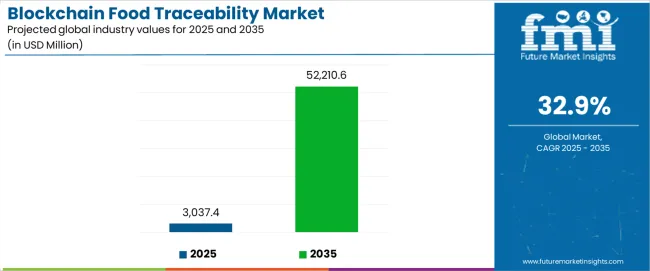
| Period | Primary Revenue Buckets | Share | Notes |
|---|---|---|---|
| Today | ToB (Enterprise) blockchain solutions | 62% | Corporate supply chains, manufacturer implementations |
| Meat, seafood and eggs traceability | 28% | High-value protein tracking, safety compliance | |
| Fruits and vegetables tracking | 18% | Produce industry, farm-to-table verification | |
| ToC (Consumer) applications | 15% | Consumer-facing transparency apps | |
| Future (3-5 yrs) | Advanced enterprise platforms | 48-52% | Integrated supply chain ecosystems |
| Government compliance systems | 22-26% | Regulatory mandates, public sector adoption | |
| Consumer engagement platforms | 18-22% | Brand transparency, QR code scanning | |
| Wine and specialty products | 8-12% | Premium product authentication | |
| Grain, oil and condiments | 6-10% | Commodity tracking, bulk processing | |
| Cross-industry integration | 4-8% | Multi-sector platforms, API ecosystems |
At-a-Glance Metrics
| Metric | Value |
|---|---|
| Market Value (2025) → | USD 3,037.4 million |
| Market Forecast (2035) ↑ | USD 52,210.6 million |
| Growth Rate ★ | 32.9% CAGR |
| Leading Type→ | ToB (Enterprise) Solutions |
| Primary Application → | Meat, Seafood and Eggs Segment |
The market demonstrates exceptional fundamentals with ToB enterprise blockchain systems capturing a dominant share through advanced distributed ledger properties and supply chain integration optimization. Meat, seafood and eggs applications drive primary demand, supported by increasing food safety requirements and supply chain transparency initiatives. Geographic expansion remains concentrated in developed markets with established food processing infrastructure, while emerging economies show accelerating adoption rates driven by export compliance modernization initiatives and rising food safety standards.
Primary Classification: The market segments by type into ToB (Enterprise), ToC (Consumer), and ToG (Government), representing the evolution from corporate supply chain solutions to comprehensive stakeholder engagement platforms for food traceability optimization.
Secondary Classification: Application segmentation divides the market into meat/seafood/eggs, fruits/vegetables, wine, grain/oil/condiments, and others, reflecting distinct requirements for tracking complexity, regulatory compliance, and consumer verification specifications.
Tertiary Classification: End-use segmentation covers food producers, processors, distributors, retailers, and regulatory agencies, while deployment models span private blockchains, consortium networks, and public ledger integrations.
Regional Classification: Geographic distribution covers North America, Latin America, Western Europe, Eastern Europe, East Asia, South Asia Pacific, and Middle East & Africa, with developed markets leading enterprise adoption while emerging economies show accelerating growth patterns driven by export compliance and food safety modernization programs.
The segmentation structure reveals classification progression from enterprise-focused blockchain implementations toward comprehensive multi-stakeholder platforms with consumer engagement capabilities, while application diversity spans from high-value protein tracking to commodity-level transparency requiring precision traceability solutions.
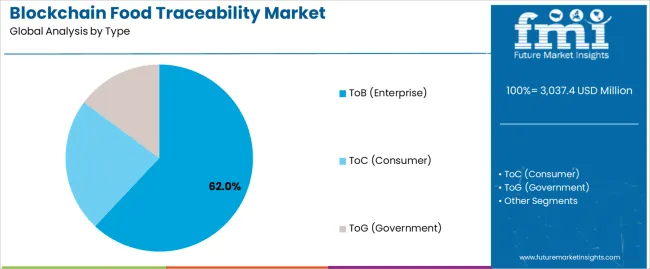
Market Position: ToB enterprise blockchain systems command the leading position in the food traceability market with 62% market share through proven distributed ledger technologies, including immutable record-keeping, supply chain integration, and compliance optimization that enable food companies to achieve comprehensive traceability across diverse production and distribution environments.
Value Drivers: The segment benefits from food industry preference for enterprise-grade blockchain platforms that provide supply chain visibility, regulatory compliance, and operational efficiency without requiring consumer-facing infrastructure. Advanced blockchain processing features enable enhanced data integrity, automated compliance reporting, and integration with existing ERP systems, where transparency performance and regulatory adherence represent critical operational requirements.
Competitive Advantages: ToB enterprise systems differentiate through proven scalability reliability, enterprise-grade security characteristics, and integration with established supply chain management systems that enhance operational effectiveness while maintaining optimal compliance standards suitable for diverse food industry applications.
Key market characteristics:
ToC consumer-facing blockchain systems maintain a 15% market position in the food traceability market due to their transparency advantages and brand engagement positioning benefits. These platforms appeal to companies requiring direct consumer communication with enhanced brand trust profiles for retail operations. Market growth is driven by consumer awareness expansion, emphasizing transparency solutions and brand differentiation through optimized consumer engagement designs.
ToG government blockchain implementations capture 23% market share through regulatory compliance requirements in food safety agencies, export certification bodies, and public health applications. These systems demand comprehensive audit capabilities that comply with government standards while providing regulatory oversight access and compliance verification capabilities.
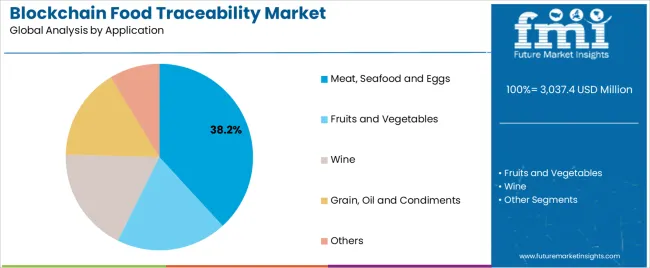
Market Context: Meat, seafood and eggs applications demonstrate strong growth in the blockchain food traceability market with 38.2% CAGR due to widespread adoption of protein tracking programs and increasing focus on food safety excellence, supply chain cost efficiency, and consumer trust applications that maximize traceability effectiveness while maintaining quality standards.
Appeal Factors: Protein producers prioritize traceability reliability, safety compliance, and integration with existing processing infrastructure that enables coordinated tracking operations across multiple supply chain stages. The segment benefits from substantial food safety investment and modernization programs that emphasize the acquisition of premium blockchain solutions for product differentiation and consumer confidence applications.
Growth Drivers: Protein industry expansion programs incorporate blockchain traceability as essential components for safety operations, while premium product growth increases demand for verification capabilities that comply with safety standards and minimize contamination risks.
Market Challenges: Complex multi-stage supply chains and processing scale complexity may limit standardization across different producers or distribution scenarios.
Application dynamics include:
Fruits and vegetables applications capture 32% market share through specialized freshness requirements in organic farms, produce distributors, and retail applications. These facilities demand real-time blockchain solutions capable of supporting perishability tracking while providing freshness verification access and quality optimization capabilities.
Wine applications account for 18% market share, including vineyard operations, wine distributors, and luxury retail requiring authentication capabilities for provenance verification and brand protection effectiveness.
Grain, oil and condiments applications maintain 12% market share, reflecting commodity-level tracking demand for bulk processing facilities, ingredient suppliers, and manufacturing applications requiring scalable traceability systems.
Market Context: Food Producers dominate the market with 35.8% CAGR, reflecting the primary demand source for blockchain traceability technology in agricultural applications and production standardization.
Business Model Advantages: Food Producers provide direct market demand for comprehensive blockchain systems, driving volume adoption and cost optimization while maintaining quality control and compliance requirements.
Operational Benefits: Food Producer applications include supply chain integration, compliance automation, and quality assurance that drive consistent demand for blockchain systems while providing access to latest distributed ledger technologies.
| Category | Factor | Impact | Why It Matters |
|---|---|---|---|
| Driver | Food safety regulations & compliance requirements (FSMA, EU regulations, import/export standards) | ★★★★★ | Growing regulatory enforcement requires immutable record-keeping with enhanced compliance capabilities and audit trail properties proven effective across food industry applications. |
| Driver | Consumer transparency demands & brand trust (food origin awareness, quality verification) | ★★★★★ | Transforms traceability requirements from "basic tracking" to "consumer engagement"; companies that offer transparency and verification features gain competitive advantage. |
| Driver | Supply chain complexity & globalization (multi-tier suppliers, international trade) | ★★★★☆ | Global food networks need comprehensive tracking; demand for end-to-end visibility and supply chain coordination expanding addressable market. |
| Restraint | Implementation costs & technical complexity (especially for small producers) | ★★★★☆ | Smaller food producers defer blockchain adoption; increases cost barriers and slows comprehensive implementation in fragmented markets. |
| Restraint | Interoperability challenges & standardization gaps (multiple blockchain platforms, data formats) | ★★★☆☆ | Competing blockchain standards offer isolated solutions and limited compatibility, potentially restricting industry-wide adoption in collaborative applications. |
| Trend | IoT integration & real-time monitoring (sensor connectivity, automated data capture) | ★★★★★ | Connected device integration, environmental monitoring, and automated data collection transform operations; IoT connectivity and real-time analytics become core value propositions. |
| Trend | ai and analytics integration & predictive insights (pattern recognition, risk assessment) | ★★★★☆ | Machine learning integration for predictive analysis and risk management; intelligent insights and automated decision-making drive competition toward analytics-enhanced solutions. |
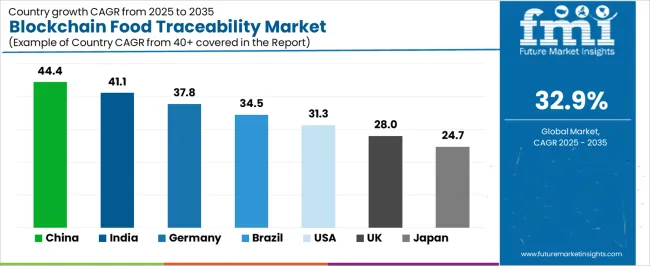
The blockchain food traceability market demonstrates varied regional dynamics with Growth Leaders including China (44.4% growth rate) and India (41.1% growth rate) driving expansion through digital agriculture initiatives and food safety modernization. Steady Performers encompass Germany (37.8% growth rate), Brazil (34.5% growth rate), and developed regions, benefiting from established food processing industries and regulatory compliance adoption. Mature Markets feature United States (31.3% growth rate), United Kingdom (28.0% growth rate), and Japan (24.7% growth rate), where food safety advancement and supply chain standardization requirements support consistent growth patterns.
Regional synthesis reveals East Asian markets leading adoption through digital transformation and export compliance development, while North American countries maintain steady expansion supported by blockchain technology advancement and regulatory standardization requirements. European markets show strong growth driven by food safety applications and traceability integration trends.
| Region/Country | 2025-2035 Growth | How to win | What to watch out |
|---|---|---|---|
| China | 44.4% | Focus on export compliance solutions | Data sovereignty regulations; local platform preferences |
| India | 41.1% | Lead with cost-effective agricultural blockchain | Infrastructure limitations; farmer adoption barriers |
| Germany | 37.8% | Provide premium compliance platforms | Over-regulation; complex approval processes |
| Brazil | 34.5% | Offer agricultural-focused solutions | Currency fluctuations; technical infrastructure gaps |
| United States | 31.3% | Push enterprise integration | Privacy regulations; interoperability challenges |
| United Kingdom | 28.0% | Focus on food safety applications | Post-Brexit compliance; supply chain disruptions |
| Japan | 24.7% | Emphasize quality assurance | Traditional supply chains; adoption resistance |
China establishes fastest market growth through aggressive digital agriculture programs and comprehensive food safety modernization, integrating advanced blockchain traceability systems as standard components in export facilities and domestic food installations. The country's 44.4% growth rate reflects government initiatives promoting food safety infrastructure and domestic blockchain capabilities that mandate the use of traceability systems in food production and export facilities. Growth concentrates in major agricultural hubs, including Shandong, Henan, and Jiangsu provinces, where food processing showcases integrated blockchain systems that appeal to producers seeking export compliance optimization capabilities and international market applications.
Chinese manufacturers are developing cost-effective blockchain solutions that combine domestic technology advantages with advanced distributed ledger features, including enhanced scalability control and improved interoperability capabilities. Distribution channels through agricultural cooperatives and technology integrators expand market access, while government support for digital agriculture supports adoption across diverse food production and processing segments.
Strategic Market Indicators:
In Maharashtra, Punjab, and Karnataka, agricultural facilities and food processors are implementing blockchain traceability systems as standard equipment for export compliance and quality optimization applications, driven by increasing government digitalization investment and agricultural modernization programs that emphasize the importance of supply chain transparency capabilities. The market holds a 41.1% growth rate, supported by government Digital India initiatives and agricultural development programs that promote blockchain systems for food production and export facilities. Indian operators are adopting blockchain solutions that provide consistent traceability capabilities and compliance features, particularly appealing in agricultural regions where export quality and international standards represent critical business requirements.
Market expansion benefits from growing digital agriculture capabilities and international trade partnerships that enable domestic development of blockchain systems for food and agricultural applications. Technology adoption follows patterns established in agricultural technology, where reliability and compliance drive procurement decisions and operational deployment.
Market Intelligence Brief:
Germany's advanced food processing market demonstrates sophisticated blockchain traceability deployment with documented compliance effectiveness in food manufacturing applications and export facilities through integration with existing quality systems and operational infrastructure. The country leverages engineering expertise in food technology and compliance systems integration to maintain a 37.8% growth rate. Food processing centers, including Bavaria, Lower Saxony, and North Rhine-Westphalia, showcase premium installations where blockchain systems integrate with comprehensive quality platforms and facility management systems to optimize supply chain transparency and operational effectiveness.
German manufacturers prioritize system reliability and EU compliance in blockchain development, creating demand for premium systems with advanced features, including facility integration and comprehensive audit systems. The market benefits from established food processing infrastructure and a willingness to invest in blockchain technologies that provide long-term operational benefits and compliance with international food safety standards.
Market Intelligence Brief:
Brazil's market expansion benefits from diverse agricultural demand, including export modernization in São Paulo and Rio Grande do Sul, food processing facility upgrades, and government agricultural programs that increasingly incorporate blockchain solutions for traceability applications. The country maintains a 34.5% growth rate, driven by rising agricultural exports and increasing recognition of blockchain benefits, including precise traceability control and enhanced export effectiveness.
Market dynamics focus on agricultural-focused blockchain solutions that balance supply chain transparency performance with cost considerations important to Brazilian producers. Growing export industrialization creates continued demand for modern blockchain systems in new agricultural infrastructure and processing modernization projects.
Strategic Market Considerations:
United States establishes market leadership through comprehensive food safety programs and advanced supply chain infrastructure development, integrating blockchain traceability systems across food production and distribution applications. The country's 31.3% growth rate reflects established food industry relationships and mature blockchain technology adoption that supports widespread use of traceability systems in food manufacturing and retail facilities. Growth concentrates in major food processing centers, including California, Iowa, and Illinois, where blockchain technology showcases mature deployment that appeals to food companies seeking proven transparency capabilities and regulatory compliance applications.
American food companies leverage established technology networks and comprehensive regulatory support capabilities, including implementation programs and compliance support that create industry relationships and operational advantages. The market benefits from mature regulatory standards and food safety requirements that mandate blockchain system use while supporting technology advancement and operational optimization.
Market Intelligence Brief:
United Kingdom's food industry demonstrates integrated blockchain traceability deployment with documented compliance effectiveness in food manufacturing applications and retail facilities through integration with existing quality systems and operational infrastructure. The country maintains a 28.0% growth rate, supported by food safety excellence programs and supply chain effectiveness requirements that promote blockchain systems for food industry applications. Food facilities across England, Scotland, and Wales showcase systematic installations where blockchain systems integrate with comprehensive quality platforms to optimize supply chain transparency and operational outcomes.
UK food companies prioritize system reliability and industry compatibility in blockchain procurement, creating demand for validated systems with proven traceability features, including quality monitoring integration and compliance reporting systems. The market benefits from established food processing infrastructure and safety requirements that support blockchain technology adoption and operational effectiveness.
Market Intelligence Brief:
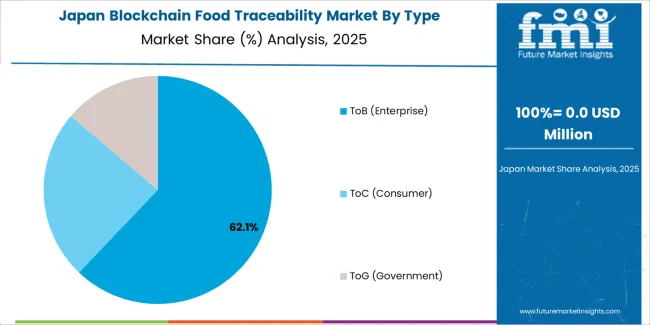
Japan's market growth benefits from precision food technology demand, including advanced processing facilities in Hokkaido and Kyushu, quality integration, and food safety enhancement programs that increasingly incorporate blockchain solutions for traceability applications. The country maintains a 24.7% growth rate, driven by food technology advancement and increasing recognition of precision blockchain benefits, including accurate supply chain control and enhanced quality outcomes.
Market dynamics focus on high-precision blockchain solutions that meet Japanese quality standards and traceability effectiveness requirements important to food processors. Advanced food technology adoption creates continued demand for sophisticated blockchain systems in processing facility infrastructure and quality modernization projects.
Strategic Market Considerations:
The European blockchain food traceability market is projected to grow from USD 842.3 million in 2025 to USD 14,578.9 million by 2035, registering a CAGR of 33.8% over the forecast period. Germany is expected to maintain its leadership position with a 41.2% market share in 2025, supported by its advanced food processing infrastructure and major agricultural centers.
United Kingdom follows with a 26.8% share in 2025, driven by comprehensive food safety programs and supply chain transparency development initiatives. France holds a 18.4% share through specialized food authentication applications and regulatory compliance requirements. Italy commands a 8.7% share, while Spain accounts for 4.9% in 2025. The rest of Europe region is anticipated to gain momentum, expanding its collective share from 2.8% to 3.2% by 2035, attributed to increasing blockchain adoption in Nordic countries and emerging food facilities implementing digital transformation programs.
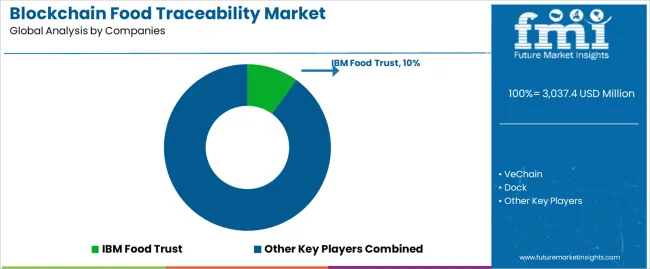
| Stakeholder | What they actually control | Typical strengths | Typical blind spots |
|---|---|---|---|
| Platform leaders | Blockchain infrastructure, ecosystem development, enterprise partnerships | Scalable platforms, proven technology, multi-industry support | Implementation complexity; customer dependency on platform evolution |
| Technology innovators | Advanced blockchain R&D; distributed ledger technologies; consensus mechanisms | Latest innovations first; attractive ROI on performance effectiveness | Service density outside core regions; scaling complexity |
| Industry specialists | Food industry compliance, supply chain integration, regulatory support | "Close to customer" expertise; pragmatic solutions; industry regulations | Technology gaps; talent retention in specialized markets |
| Full-service providers | Complete implementations, training services, ongoing support | Lowest operational risk; comprehensive solutions | Service costs if overpromised; technology obsolescence |
| Niche specialists | Specialized applications, custom blockchain solutions, vertical integration | Win premium applications; flexible configurations | Scalability limitations; narrow market focus |
| Item | Value |
|---|---|
| Quantitative Units | USD 3,037.4 million |
| Type | ToB (Enterprise), ToC (Consumer), ToG (Government) |
| Application | Meat/Seafood/Eggs, Fruits/Vegetables, Wine, Grain/Oil/Condiments, Others |
| End Use | Food Producers, Processors, Distributors, Retailers, Regulatory Agencies |
| Regions Covered | North America, Latin America, Western Europe, Eastern Europe, East Asia, South Asia Pacific, Middle East & Africa |
| Countries Covered | China, India, Germany, Brazil, United States, United Kingdom, Japan, Canada, France, Australia, and 25+ additional countries |
| Key Companies Profiled | IBM Food Trust, VeChain, Dock, ANTCHaiN, TE-FOOD, Tracefood, TraceX Technologies, Connecting Food, Wholechain |
| Additional Attributes | Dollar sales by type and application categories, regional adoption trends across East Asia, North America, and Western Europe, competitive landscape with blockchain platform providers and technology integrators, food industry operator preferences for traceability effectiveness and supply chain transparency, integration with IoT platforms and analytics systems, innovations in distributed ledger technology and blockchain enhancement, and development of advanced blockchain solutions with enhanced scalability and operational optimization capabilities. |
The global blockchain food traceability market is estimated to be valued at USD 3,037.4 million in 2025.
The market size for the blockchain food traceability market is projected to reach USD 52,210.6 million by 2035.
The blockchain food traceability market is expected to grow at a 32.9% CAGR between 2025 and 2035.
The key product types in blockchain food traceability market are tob (enterprise), toc (consumer) and tog (government).
In terms of application, meat, seafood and eggs segment to command 38.2% share in the blockchain food traceability market in 2025.






Our Research Products

The "Full Research Suite" delivers actionable market intel, deep dives on markets or technologies, so clients act faster, cut risk, and unlock growth.

The Leaderboard benchmarks and ranks top vendors, classifying them as Established Leaders, Leading Challengers, or Disruptors & Challengers.

Locates where complements amplify value and substitutes erode it, forecasting net impact by horizon

We deliver granular, decision-grade intel: market sizing, 5-year forecasts, pricing, adoption, usage, revenue, and operational KPIs—plus competitor tracking, regulation, and value chains—across 60 countries broadly.

Spot the shifts before they hit your P&L. We track inflection points, adoption curves, pricing moves, and ecosystem plays to show where demand is heading, why it is changing, and what to do next across high-growth markets and disruptive tech

Real-time reads of user behavior. We track shifting priorities, perceptions of today’s and next-gen services, and provider experience, then pace how fast tech moves from trial to adoption, blending buyer, consumer, and channel inputs with social signals (#WhySwitch, #UX).

Partner with our analyst team to build a custom report designed around your business priorities. From analysing market trends to assessing competitors or crafting bespoke datasets, we tailor insights to your needs.
Supplier Intelligence
Discovery & Profiling
Capacity & Footprint
Performance & Risk
Compliance & Governance
Commercial Readiness
Who Supplies Whom
Scorecards & Shortlists
Playbooks & Docs
Category Intelligence
Definition & Scope
Demand & Use Cases
Cost Drivers
Market Structure
Supply Chain Map
Trade & Policy
Operating Norms
Deliverables
Buyer Intelligence
Account Basics
Spend & Scope
Procurement Model
Vendor Requirements
Terms & Policies
Entry Strategy
Pain Points & Triggers
Outputs
Pricing Analysis
Benchmarks
Trends
Should-Cost
Indexation
Landed Cost
Commercial Terms
Deliverables
Brand Analysis
Positioning & Value Prop
Share & Presence
Customer Evidence
Go-to-Market
Digital & Reputation
Compliance & Trust
KPIs & Gaps
Outputs
Full Research Suite comprises of:
Market outlook & trends analysis
Interviews & case studies
Strategic recommendations
Vendor profiles & capabilities analysis
5-year forecasts
8 regions and 60+ country-level data splits
Market segment data splits
12 months of continuous data updates
DELIVERED AS:
PDF EXCEL ONLINE
Food Traceability Market Size and Share Forecast Outlook 2025 to 2035
Blockchain in Agriculture and Food Supply Chain Market Size and Share Forecast Outlook 2025 to 2035
Food & Beverage OEE Software Market Size and Share Forecast Outlook 2025 to 2035
Food Grade Crosslinked Polyvinylpolypyrrolidone (PVPP) Market Size and Share Forecast Outlook 2025 to 2035
Food Grade Cassia Gum Powder Market Size and Share Forecast Outlook 2025 to 2035
Food Grade Dry Film Lubricant Market Size and Share Forecast Outlook 2025 to 2035
Foodservice Equipment Market Analysis - Size, Share, and Forecast Outlook 2025 to 2035
Food Basket Market Forecast and Outlook 2025 to 2035
Food Grade Tremella Polysaccharide Market Size and Share Forecast Outlook 2025 to 2035
Blockchain Interoperability Market Size and Share Forecast Outlook 2025 to 2035
Food Sorting Machine Market Size and Share Forecast Outlook 2025 to 2035
Foodservice Paper Bag Market Size and Share Forecast Outlook 2025 to 2035
Food Stabilizers Market Size and Share Forecast Outlook 2025 to 2035
Food Packaging Film Market Size and Share Forecast Outlook 2025 to 2035
Food Certification Market Size and Share Forecast Outlook 2025 to 2035
Food Tray Market Size and Share Forecast Outlook 2025 to 2035
Food & Beverage Industrial Disinfection and Cleaning Market Size and Share Forecast Outlook 2025 to 2035
Blockchain AI Market Size and Share Forecast Outlook 2025 to 2035
Food Technology Market Size and Share Forecast Outlook 2025 to 2035
Food Tourism Sector Market Size and Share Forecast Outlook 2025 to 2035

Thank you!
You will receive an email from our Business Development Manager. Please be sure to check your SPAM/JUNK folder too.
Chat With
MaRIA